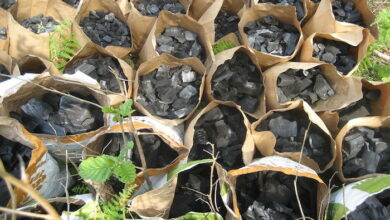
Soil Formation
Soil is formed through the process of rock weathering. Weathering is the breakdown of rocks into smaller particles when in contact with water (flowing through rocks), air or living organisms. Weathering can occur physically, biologically or chemically.
Physical weathering: This is the disintegration of rocks into smaller particles with no alteration in their molecular structure. Air and water are agents of physical weathering. Windblown on rocks, heavy downpour of rain, water waves from the sea can facilitate a gradual fragmentation of rock particles to sediments which eventually become soil.
Chemical weathering: In chemical weathering chemical reactions within rocks create changes in their mineral composition. Examples of chemical reactions leading to weathering are hydrolysis, carbonation, oxidation and hydration.
• Hydrolysis: hydrolysis occurs as rain water seeps through rocks and the hydrogen ion (H+) in water reacts with metallic ions in rocks resulting in dissolution of rock minerals.
• Carbonation: During carbonation carbon dioxide from the air and from living organisms dissolve in water to form carbonic acid. This acidifies water in rocks leading to further chemical reaction with rock minerals.
• Oxidation: in oxidation oxygen from the air reacts with iron in rocks to form iron oxides. This reaction creates a rusty brown colouration on rocks.
Biological weathering: In this process biological organisms facilitate rock fragmentation. Tree roots and mosses grow or penetrate through rocks and create pore spaces which gradually pull rocks apart. Animals burrow through rocks and create disintegration. Micro organisms like lichen (a symbiotic relationship between fungi and algae) release chemicals which break down rock minerals.
Table 1: The Eight most abundant elements present in igneous, sedimentary and metamorphic rocks

Factors influencing soil formation
Factors affecting soil formation are: climate, topography, living organisms, parent material and time.
Climate
Climate contributes largely to soil formation. Rainfall and temperature pattern in a location influence the type of soils formed in that area. Rain provides water which facilitates chemical and physical weathering. Different climates around the world create diversity in soil nature and property. For example, soil is more exposed to erosion, weathering and leaching in places of high or heavy rainfall. Acidic soils are also more prevalent in such places because minerals such as calcium, magnesium, potassium are often replaced by H+ from rain water. Alternatively, places of low rainfall are less vulnerable to leaching. Soils in these regions tend towards high alkalinity because in the absence of leaching calcium carbonates build up in the upper soil layers1. Warmer temperatures encourage rapid weathering as plants and microbial activities flourish while colder climates encourage gradual rock weathering.
Topography
Topography can be defined as the shape of the earth’s surface area. The steepness of a land increases its vulnerability to water and wind erosion; leading to the movement of rock sediments and washing downwards of rock minerals to valleys.

Soils in the valleys of these regions are darker coloured, rich in organic matter and more fertile for plant growth while soils on hilltops are eroded, less fertile and unfavourable for plant growth.
Living organisms
Living organisms play a key role in soil formation. An area with high vegetation is usually rich in humus. Humus builds up as fallen leaves and dead plant parts are decomposed by soil micro organisms to become organic matter. The micro organisms feed on sugars and carbohydrates in organic matter leaving behind fats and waxes in the soil. This is what accounts for the humus.
Parent material
Soil parent material is mainly weathered rock. Parent material can be sedimentary rocks, igneous rocks or geologically young sediments that overlie the bedrocks. Soil type depends on the parent material from which it was formed. Soil formed from weathered granite rocks becomes sand. Granite contains quartz a silicate mineral very resistant to weathering. As quartz is highly resistant to weathering granite disintegrates into gritty sand particles. Likewise rocks containing feldspar (a mineral silicate with low resistance to weathering is broken down into fine clay particles.
Time
Time is a key factor that holds and relates with all other soil forming factors. Soil formation will occur more rapidly where the climatic, topographic or biological conditions are favourable for weathering. Time also shows how long other soil forming factors have been in play. Regions with young parent material are usually more fertile because they have not undergone much weathering and therefore have a large quantity of mineral contents still present. In the same way places with older parent material subjected to a lot more weathering would have less amount of mineral composition. These types of soils depend more on organic matter for their nutrients.
Bibliography and Websites for Further Reading
1. Miller RW, Gardiner DT (1998) Soils in Our Environment, 8th Edition. Prentice Hall, New Jersey.
2. Gerrard J (2000) Fundamentals of soils. Routledge, London
3. Harpstead M, Sauer TJ, Bennett WF (2001) Soil Science Simplified. 4th Edition. Iowa State Press, Iowa.
4. https://geology.com/rocks/granite.shtml
5. https://passel.unl.edu/pages/informationmodule.php?idinformationmodule=1130447023&topicorder=7&maxto=7&minto=1













Help me reach you please